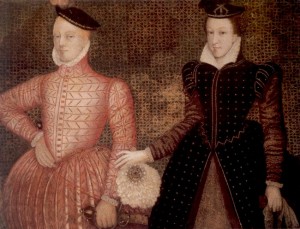The Mysterious Murder of Lord Darnley
Today I am happy to have finally got news of a forthcoming publication which has been long awaited by the contributors, one of whom is myself. This is a book named Crimelights: Scottish Crime Writing - Then and Now, a collection of articles that sprung from a conference on Scottish Crime that was held in Göttingen, Germany, in 2012. It includes articles on Ian Rankin, Sherlock Holmes, Robert Louis Stevenson, Louise Welsh, Denise Mina, Josephine Tey and others. My article in this collection focuses on Mary Queen of Scots and the murder of her husband, Henry Stuart, Lord Darnley, on 10 February 1567, and how this has been represented in fiction and film.

Above: Mary Queen of Scots with her second husband, Henry Stuart, Lord Darnley (on the left)
I have already published another article on Mary and how she is presented as a feminine and national icon in literature and film. My work on Mary is ongoing and placed alongside further work on representations of the Tudor family in fiction and film, within the greater context of historical fiction. Along with colleagues in Wales, I am co-organizing a conference on "Representing the Tudors", which takes place at the University of South Wales this summer, 10-11 July. We have a confirmed keynote speaker, Dr Jerome de Groot of Manchester University, and some exciting news regarding other keynote speakers will be released soon. The murder of Lord Darnley is one of history's great mysteries, as is the question of his wife's involvement in the crime. Interpretations of the crime and of Mary (and Bothwell's) guilt vary in fictional representations, and I discuss some of these in my article.
Below is an excerpt from my forthcoming article:
The murder of Lord Darnley is one of the most debated crimes in history, even though it is generally accepted by commentators that Bothwell was one of the chief perpetrators. This is because the events before and on the 10th of February 1567 are still shrouded in mystery, or as Mary’s biographer John Guy puts it: “In a debate lasting over four hundred years, no one has given a wholly satisfactory explanation of what happened on that night, or why” (281). Importantly, also, not all have been in agreement as to whether or not Mary was accessory to Darnley’s murder, while the issue of whether Mary and Bothwell had become lovers before Darnley’s death is also much debated, and is intrinsically linked to the mystery surrounding the assassination. This uncertainty has proved central to a fundamental split in representations of and opinion on Mary through the ages, which to a great extent originates from two very opposing sources, as outlined by Jayne Lewis: the Protestant George Buchanan’s damning Detection of the Douings of Marie (1571), which presented Mary as a “poisoning witch” who killed Darnley and even took pleasure in doing so (qtd. in Lewis, “Reputations”), and the Catholic Bishop John Leslie’s Defence of the Honour of . . . Marie (1569), which showed Mary as a “most careful, tender mother with all” whose “godly and virtuous life past” dispels all suspicion of her guilt (qtd. in Lewis, “Reputations” n. p.). The blatant opposition between these two accounts of Mary’s actions has set the tone for much of the critical debate on her story in the centuries to follow and has, understandably, also made its mark on representations of Mary in literature and the arts. For more than two centuries, these have varied from Mary as “heroine of sensibility to romantic guilty grande dame,” as outlined by Michael Dobson and Nicola J. Watson (100).
